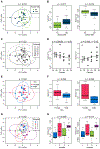The Assessment of Fecal Volatile Organic Compounds in Healthy Infants: Electronic Nose Device Predicts Patient Demographics and Microbial Enterotype
- PMID: 32526503
- PMCID: PMC7483828
- DOI: 10.1016/j.jss.2020.05.010
The Assessment of Fecal Volatile Organic Compounds in Healthy Infants: Electronic Nose Device Predicts Patient Demographics and Microbial Enterotype
Abstract
Background: The assessment of fecal volatile organic compounds (VOCs) has emerged as a noninvasive biomarker in many different pathologies. Before assessing whether VOCs can be used to diagnose intestinal diseases, including necrotizing enterocolitis (NEC), it is necessary to measure the impact of variable infant demographic factors on VOC signals.
Materials and methods: Stool samples were collected from term infants at four hospitals in a large metropolitan area. Samples were heated, and fecal VOCs assessed by the Cyranose 320 Electronic Nose. Twenty-eight sensors were combined into an overall smellprint and were also assessed individually. 16s rRNA gene sequencing was used to categorize infant microbiomes. Smellprints were correlated to feeding type (formula versus breastmilk), sex, hospital of birth, and microbial enterotype. Overall smellprints were assessed by PERMANOVA with Euclidean distances, and individual sensors from each smellprint were assessed by Mann-Whitney U-tests. P < 0.05 was significant.
Results: Overall smellprints were significantly different according to diet. Individual sensors were significantly different according to sex and hospital of birth, but overall smellprints were not significantly different. Using a decision tree model, two individual sensors could reliably predict microbial enterotype.
Conclusions: Assessment of fecal VOCs with an electronic nose is impacted by several demographic characteristics of infants and can be used to predict microbiome composition. Further studies are needed to design appropriate algorithms that are able to predict NEC based on fecal VOC profiles.
Keywords: Biomarkers; Electronic nose; Enterotype; Fecal volatile organic compounds; Necrotizing enterocolitis.
Copyright © 2020 Elsevier Inc. All rights reserved.
Figures





Similar articles
-
The Impact of Storage Conditions on Stool Smellprints as Assessed by an Electronic Nose.ACS Sens. 2025 Feb 28;10(2):689-698. doi: 10.1021/acssensors.4c01807. Epub 2025 Jan 16. ACS Sens. 2025. PMID: 39817811
-
The assessment of microbiome changes and fecal volatile organic compounds during experimental necrotizing enterocolitis.J Pediatr Surg. 2021 Jun;56(6):1220-1225. doi: 10.1016/j.jpedsurg.2021.02.043. Epub 2021 Feb 24. J Pediatr Surg. 2021. PMID: 33745738 Free PMC article.
-
Electronic nose can discriminate colorectal carcinoma and advanced adenomas by fecal volatile biomarker analysis: proof of principle study.Int J Cancer. 2014 Mar 1;134(5):1132-8. doi: 10.1002/ijc.28446. Epub 2013 Sep 2. Int J Cancer. 2014. PMID: 23959518
-
The potential of gut microbiota and fecal volatile organic compounds analysis as early diagnostic biomarker for necrotizing enterocolitis and sepsis in preterm infants.Expert Rev Gastroenterol Hepatol. 2018 May;12(5):457-470. doi: 10.1080/17474124.2018.1446826. Epub 2018 Mar 6. Expert Rev Gastroenterol Hepatol. 2018. PMID: 29488419 Review.
-
Diagnosing gastrointestinal illnesses using fecal headspace volatile organic compounds.World J Gastroenterol. 2016 Jan 28;22(4):1639-49. doi: 10.3748/wjg.v22.i4.1639. World J Gastroenterol. 2016. PMID: 26819529 Free PMC article. Review.
Cited by
-
E-Tongues/Noses Based on Conducting Polymers and Composite Materials: Expanding the Possibilities in Complex Analytical Sensing.Sensors (Basel). 2021 Jul 22;21(15):4976. doi: 10.3390/s21154976. Sensors (Basel). 2021. PMID: 34372213 Free PMC article. Review.
-
Hydrogen Sulfide Improves Outcomes in a Murine Model of Necrotizing Enterocolitis via the Cys440 Residue on Endothelial Nitric Oxide Synthase.J Pediatr Surg. 2023 Dec;58(12):2391-2398. doi: 10.1016/j.jpedsurg.2023.08.006. Epub 2023 Aug 18. J Pediatr Surg. 2023. PMID: 37684170 Free PMC article.
-
Emerging prediction methods for early diagnosis of necrotizing enterocolitis.Front Med (Lausanne). 2022 Sep 16;9:985219. doi: 10.3389/fmed.2022.985219. eCollection 2022. Front Med (Lausanne). 2022. PMID: 36186788 Free PMC article. Review.
-
The Potential of Fecal Volatile Organic Compound Analysis for the Early Diagnosis of Late-Onset Sepsis in Preterm Infants: A Narrative Review.Sensors (Basel). 2024 May 16;24(10):3162. doi: 10.3390/s24103162. Sensors (Basel). 2024. PMID: 38794014 Free PMC article. Review.
-
Quantification of cancer biomarkers in urine using volatilomic approach.Heliyon. 2024 Oct 5;10(19):e39028. doi: 10.1016/j.heliyon.2024.e39028. eCollection 2024 Oct 15. Heliyon. 2024. PMID: 39435108 Free PMC article.
References
-
- Ahmed I, et al., Sniffing out causes of gastrointestinal disorders: a review of volatile metabolomic biomarkers. Biomark Med, 2018. 12(10): p. 1139–1148. - PubMed
-
- Kumar V, Abbas AK, and Aster JC, Robbins and Cotran pathologic basis of disease. 2015, Elsevier/Saunders: Philadelphia, PA: p. xvi, 1391 pages.
-
- McCulloch M, et al., Diagnostic accuracy of canine scent detection in early- and late-stage lung and breast cancers. Integr Cancer Ther, 2006. 5(1): p. 30–9. - PubMed
Publication types
MeSH terms
Substances
Grants and funding
LinkOut - more resources
Full Text Sources
Medical

